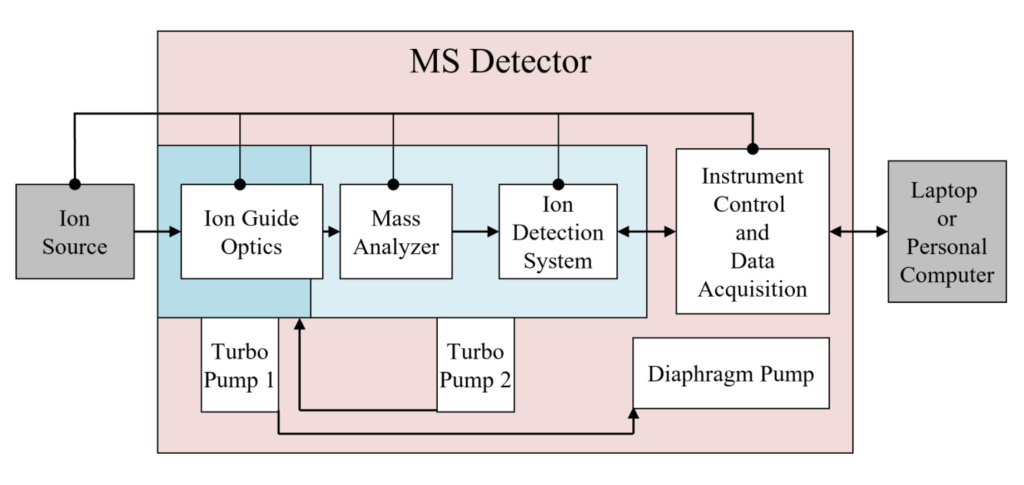X
AP/MALDI
Atmospheric pressure MALDI ionization represents a breakthrough in atmospheric pressure mass spectrometry, offering efficient and versatile ionization capabilities. Its compatibility with various instruments, rapid interchangeability, and flexibility in sample composition make AP/MALDI a valuable tool for scientists seeking advanced ionization techniques for their analytical needs.
What is MALDI?
In Laser Desorption Ionization (LDI), a sample is placed on a surface (usually a steel plate: “target plate”) and subjected to laser irradiation. Read more about the 2002 Nobel Prize in Chemistry for MALDI here (NOBEL INFO HERE). A slightly advanced version of LDI uses UV absorbing compounds called “matrices” hence the Matrix Assisted LDI (MALDI). The matrix absorbs laser energy, aiding in the desorption and ionization of analyte molecules present in the sample.
What is AP/MALDI?
The traditional MALDI instruments achieve desorption/ionization under vacuum or low pressure. AP/MALDI stands out for its operation at atmospheric pressure. AP/MALDI facilitates ionization in ambient conditions. This eliminates the need for time-consuming pump-down processes, offering rapid and efficient sample analysis. The atmospheric pressure operation of the AP/MALDI allows for the use of volatile or semi-volatile solvents and matrices in the sample. Atmospheric pressure operation expands the range of analytes that can be effectively analyzed, introducing new possibilities for MALDI applications.
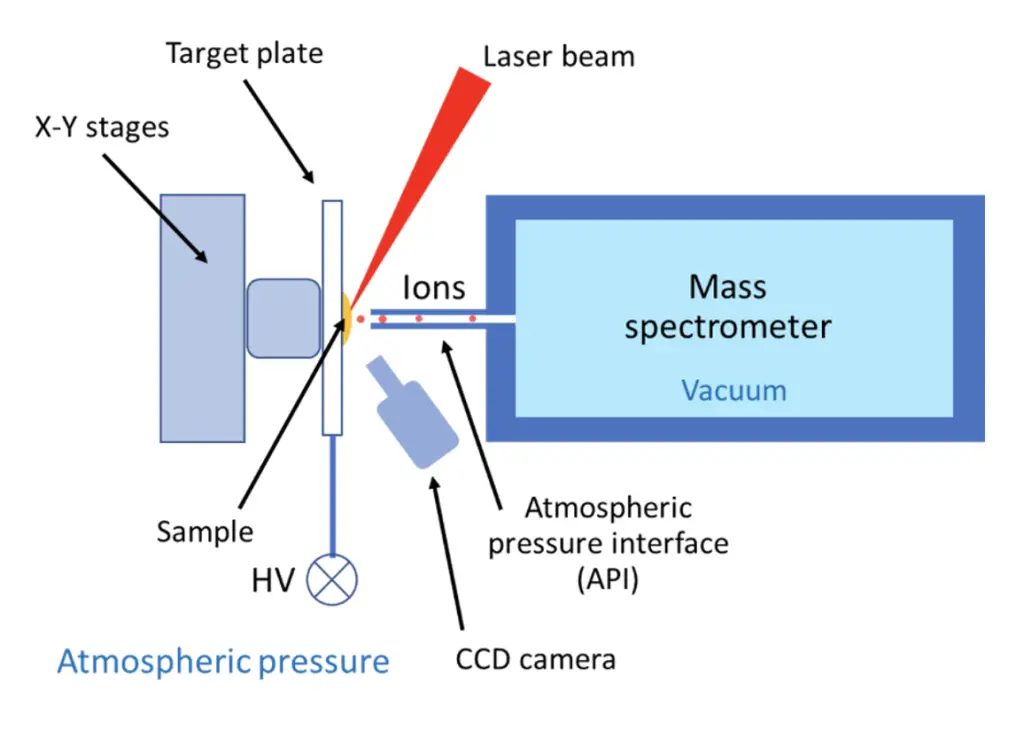
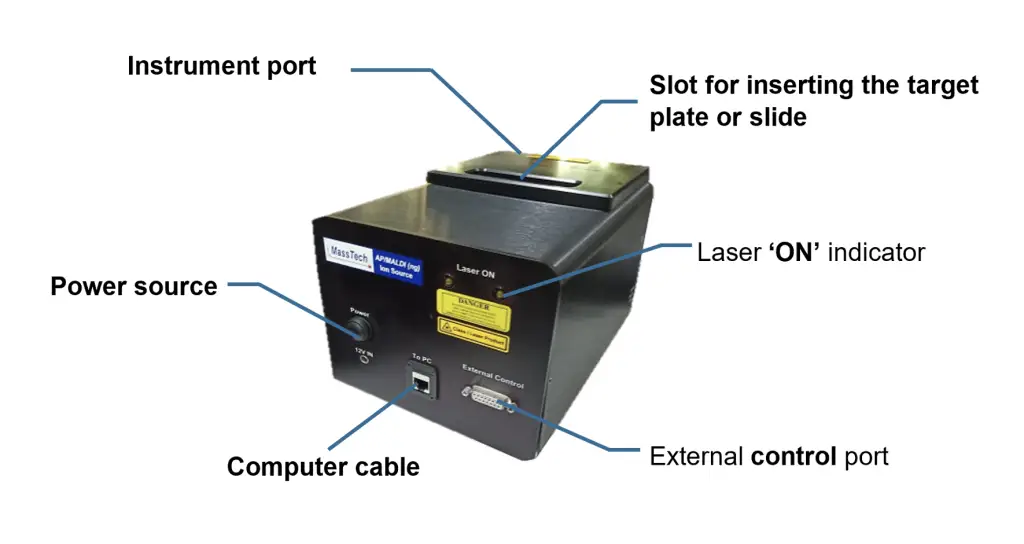
What kind of laser is used in AP/MALDI?
A solid-state, Nd:YAG, Class 1 laser emitting ultraviolet pulses at 355nm is used to irradiate samples.
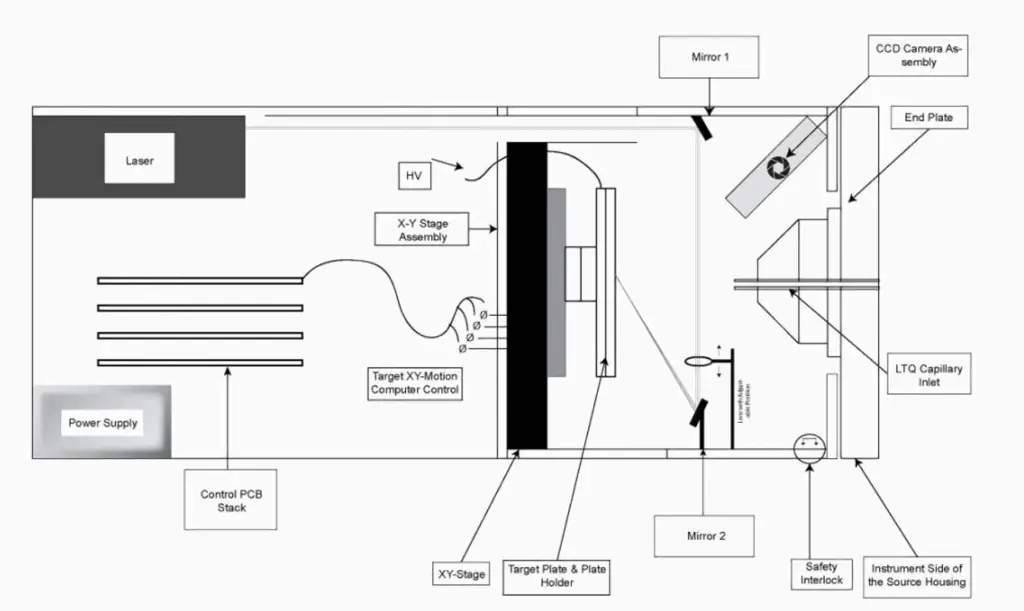
How are ions generated?
Desorption and Ionization:
The desorption of the matrix is coupled with the desorption of the analyte molecules from the sample. The high-energy laser pulse effectively releases both matrix and analyte into the gas phase. Co-crystallization of matrix and analyte is necessary for efficient ionization. In the gas phase, the analyte molecules acquire a positive or negative charge, depending on the matrix and sample. For example, α-Cyano-4-Hydroxycinnamic Acid (CHCA) is used for positive mode ionization, while 9-aminoacridine (9-AA) is used for negative mode analysis. The AP/MALDI is a soft ionization source, mostly producing singly charged ions without molecular fragmentation.
What happens after ionization?
The newly formed ions, including the ionized analyte molecules, are then introduced into the mass spectrometer for analysis. The mass spectrometer separates and detects these ions based on their mass-to-charge ratios. It is vital to generate ions in proximity to the MS inlet. AP/MALDI has been optimally designed to enable ion generation within a few millimeters from the inlet capillary.
AP/MALDI with diverse mass analyzers:
The AP/MALDI has the ability to interface with Ion Traps, high resolution Orbitraps, Time of Flights (TOFs), Quadrupole Time of Flights (QTOFs), and Triple Quadrupoles (QqQs) to obtain rich and complementary MS data.
What is MS Imaging?
MS Imaging is an application of AP/MALDI used to analyze the spatial distribution of molecules in a sample. Common samples include tissue planes and other biological matrices. The intensity variation of molecules in the sample is displayed through color maps such as the one below:
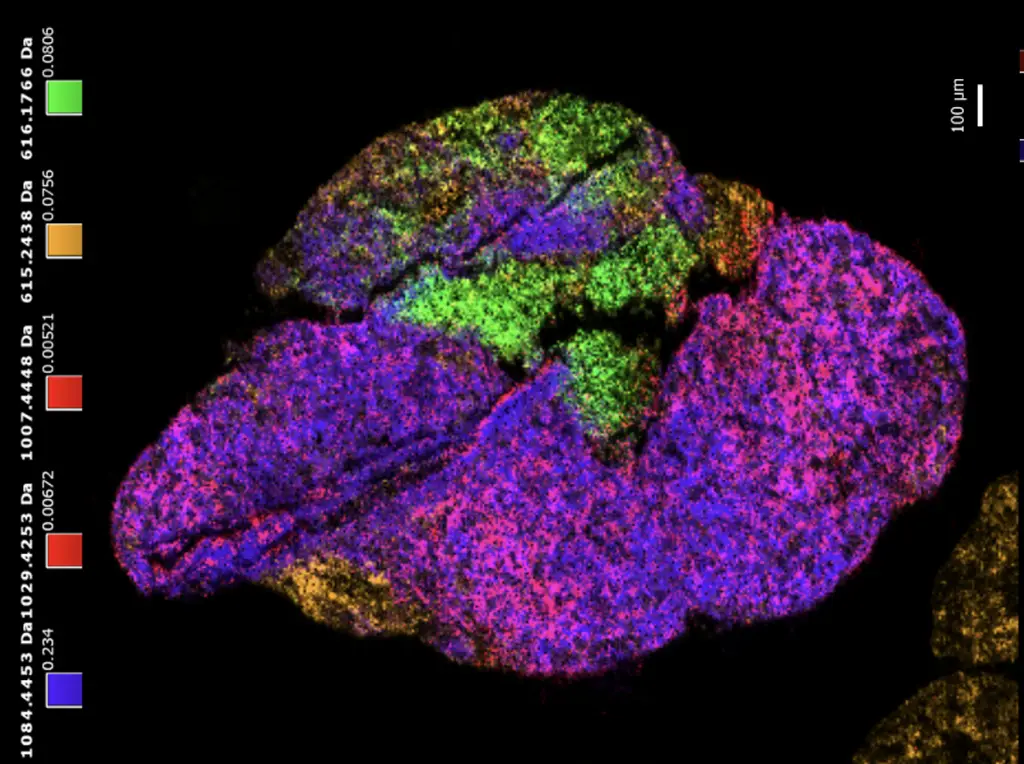
Homo sapiens FFPE tumor tissue imaged with AP/MALDI Exploris480 at 5 um resolution
What are the applications of AP/MALDI?
Mass spectrometry imaging of biological and non-biological surfaces, analysis of peptides, lipids, glycans, metabolites, pharmaceuticals, polymers, insoluble impurities, pigments, dyes, and more.
See applications page for more details and downloadable application notes.
Can insoluble materials and polymers be analyzed with AP/MALDI?
Yes, solid samples can be placed on the target plate and directly ionized using a variety of sample preparation approaches. Several AP/MALDI users have advantageously used this capability to glean insights into complex materials.
Can AP/MALDI be used for high-throughput and quantitative analysis?
Yes, standard 192 well plate inserts supplied with AP/MALDI can efficiently be used for high-throughput analysis. Automated batch data acquisition is possible with AP/MALDI on most HR MS and QqQ analyzers. The LDI process using AP/MALDI is highly reproducible and has been used for quantitative analysis in several contexts.
X
MT Explorer 30
Experience unparalleled precision and flexibility in scientific analysis with the MT Explorer 30, setting new standards in miniaturized Ion Trap Mass Spectrometry technology.
Front-End Flexibility with Atmospheric Pressure Interface (API):
The MT Explorer 30 incorporates an interchangeable Atmospheric Pressure (AP) Ionization Source (IS) externally attached to the ITMS. This standard feature allows efficient analysis of various chemicals using the same mass analyzer. MassTech manufactures a variety of rapidly interchangeable ionization sources tailored to the MT Explorer 30—direct sampling (DSAP), chemical ionization (APCI), electrospray ionization (ESI), and matrix-assisted laser desorption ionization (MALDI)—to suit any analytical need.
Efficient Ion Transmission:
Utilizing a novel technique, Pulsed Dynamic Focusing (PDF), the MT Explorer 30 significantly improves ion transmission efficiency. PDF involves pulsing a high-voltage extraction field to zero precisely when ions are just outside the MS entrance, allowing efficient ion intake into the vacuum of the mass analyzer.
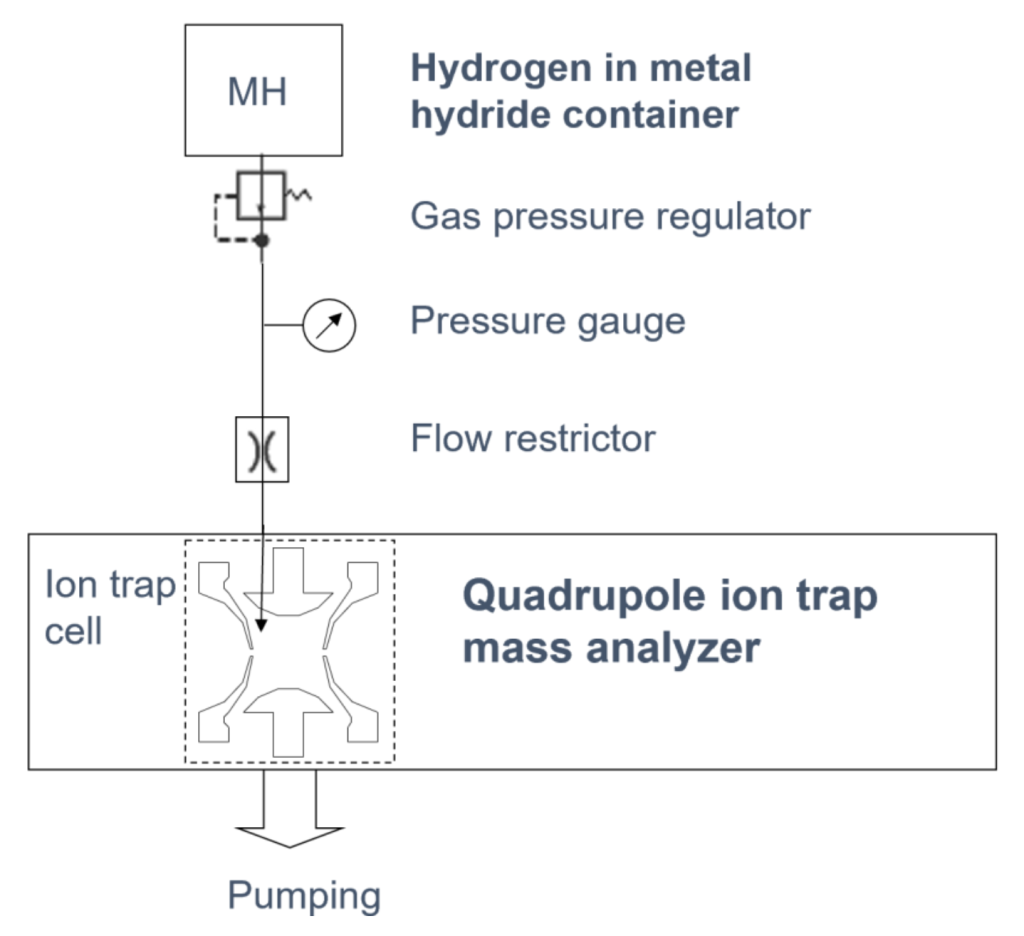
Precision Ion Handling:
The ion transfer system, equipped with hexapole ion guides, ensures precise ion focusing and acceleration. Conductance-limiting diaphragms minimize ion losses due to collisions, maintaining optimal efficiency.
Ion Trap Mass Analyzer:
The MT Explorer 30’s mass analyzer operates in a vacuum, measuring mass-to-charge ratios of ions with precision. Selected ions are stored in an ion trap, where a light buffer gas (H2 or He) cools and fragments ions for accurate analysis. The MTE 30 is accompanied by Horizon Educational’s Hydrofill®Pro, which uses distilled/deionized water to generate the hydrogen gas required for MTE 30 operation at an extremely low lifetime cost.
Ion Dynamics in the Ion Trap:
Within the ion trap, the oscillating electric field influences the trajectories of ions. Some ions acquire stable trajectories and remain trapped, while others exhibit unstable trajectories. Those with unstable trajectories are ejected through a hole in the exit end cap electrode.
- End Caps:
The end caps serve as crucial components, and they can be either grounded or biased with direct current (DC) or alternating current (AC) potentials. The potential on the end caps influences the behavior of ions within the trap. - Ring Electrode:
Positioned between the end caps, the ring electrode plays a pivotal role. It receives a sinusoidal radiofrequency (RF) high voltage. This oscillating electric field created by the RF voltage confines a batch of ions within the ion trap.
Versatile Scan Modes:
The MT Explorer 30 has the capacity for various scan modes/types, encompassing the loading, fragmentation, and ejection of ions from the mass analyzer. This adaptability enables scientists to conduct Mass Spectrometry (MS) and tandem MS (MS/MS) experiments and presents a diverse range of analytical possibilities. The MT Explorer 30’s data handling software, MODAS®, allows for multi-factor method optimization.
Ion Detection System:
A sophisticated ion detection system, consisting of a conversion dynode electrode and a multiplier, amplifies and detects ion currents. The resulting signals are processed, stored, and displayed via MODAS®, MassTech’s own data handling software.
